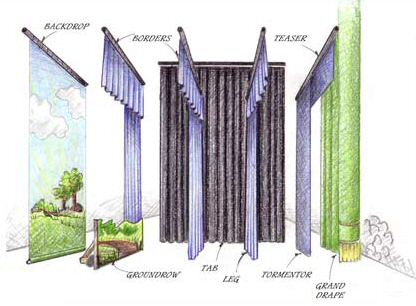
Theater drapes and stage curtains are large pieces of cloth that are designed to mask backstage areas of a theater from spectators. They are designed for a variety of specific purposes, moving in different ways (if at all) and constructed from various fabrics. Many are made from black or other darkly colored, light-absorbing material (In North America, for example, heavyweight velour is the current industry standard[1]). Theater drapes represent a portion of any production's soft goods, a category comprising any non-wardrobe, cloth-based element of the stage or scenery.[2] Theater curtains are often pocketed at the bottom to hold weighty chain or to accept pipes to remove their fullness and stretch them tight.
Proscenium stages use a greater variety of drapes than arena or thrust stages. In proscenium theaters, drapes are typically suspended from battens and can be controlled by a fly system (i.e., they are "flown," in theater terminology). When a drape is flown, the task of adjusting its height for best masking effect is simplified and, in the case of a drape that must be moved during a performance, this enables the drape to be quickly raised above the proscenium arch—thus positioning it out of view of spectators—or lowered to any desired height above the stage. In flying, instead of using the directions "down" and "up," drapes and curtains are flown "in" and "out," respectively.
- ^ Cite error: The named reference
Gillettewas invoked but never defined (see the help page). - ^ Holloway, John (2010). Illustrated Theatre Production Guide (Second ed.). Burlington, MA: Elsevier. p. 49. ISBN 978-0-240-81204-5.
